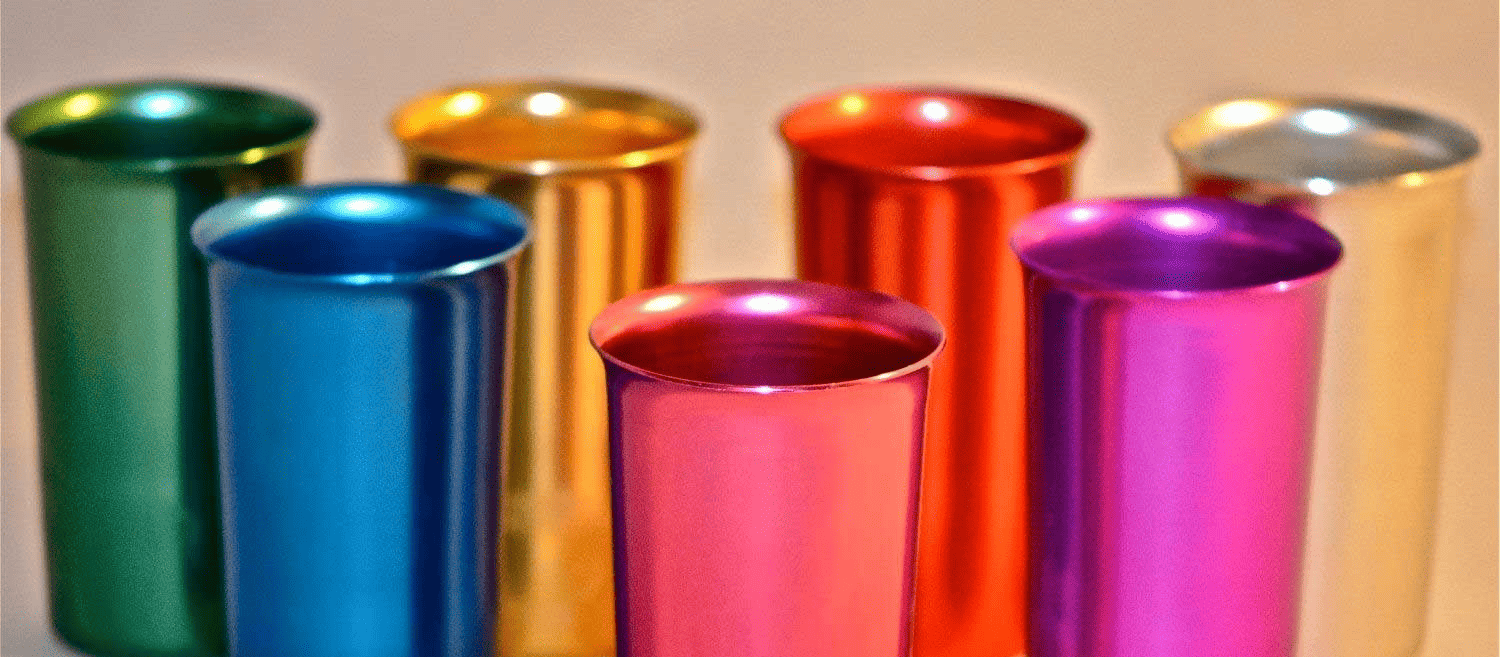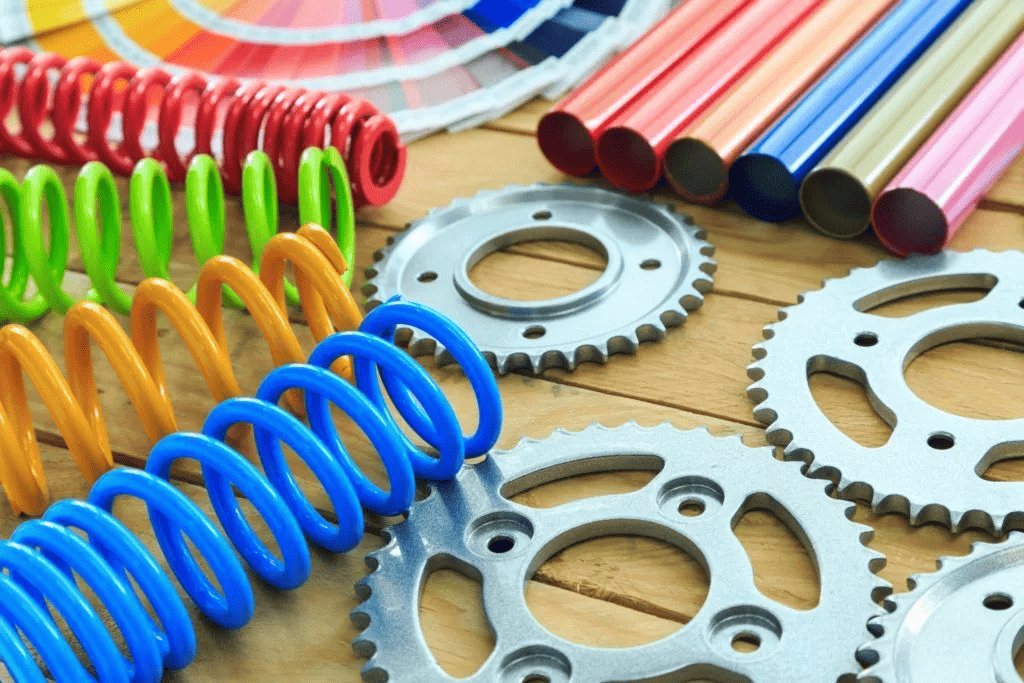When embarking on a project that involves metal surfaces, selecting the ideal finish is crucial for the final product’s durability, appearance, and longevity. Two of the most popular finishes are anodized and powder coat, each offering unique benefits and drawbacks. But how do you determine which finish is best suited for your specific needs? This blog post will provide a comprehensive comparison of anodized vs powder coat finishes, guiding you in making an informed decision for your project.
Short Summary
- Comparing Anodized vs Powder Coat requires understanding the key differences in terms of durability, appearance and environmental impact.
- Anodizing provides greater corrosion resistance but has limited color options, while powder coating offers a wide range of colors and finishes.
- Factors to consider when choosing between anodized or powder coat include cost, desired aesthetics and compliance with environmental regulations.
Understanding Anodized and Powder Coating Processes

Anodized aluminum...
Anodizing and powder coating are two distinct methods used to enhance and protect metal surfaces. Anodizing is an electrochemical process that forms a protective oxide layer on aluminum surfaces, while powder coating is a dry finishing process utilizing finely ground pigment and resin particles to create a protective layer on metal objects.
Each process offers unique advantages and disadvantages, which we will explore further in the following sections.
Anodizing Process
Anodizing is a surface treatment that increases the thickness and strength of the naturally formed oxide layer on metals like aluminum, providing enhanced resistance to wear, corrosion, and heat dissipation. The process involves immersing the aluminum surface in an electrolytic bath, which forms a protective aluminum oxide layer on the surface. Anodized coatings are popular across various industries due to their precise application and positive environmental impact.
Anodized aluminum is a popular choice for manufacturing industries. However, other metals such as bronze, gold, steel, etc., can also be anodized. This versatile process offers numerous benefits, making it an attractive choice for various applications.
Powder Coating Process
Powder coating is a dry finishing process that applies a protective and decorative layer to various substrates. Here’s how it works:
- An electrostatic charge is applied to a powder.
- This powder is then spread onto the grounded part of the process.
- Suitable for metals that can withstand the necessary curing temperatures, powder coating can also be applied to certain plastics, glass, and fiberboards.
The powder coating process offers numerous benefits, including a broad selection of colors and surface finishes, as well as reduced air pollution compared to liquid coatings due to the emission of no volatile organic compounds (VOCs). However, it is essential to have a proficient operator to achieve a high-quality powder coat.
Comparing Key Features of Anodized and Powder Coat Finishes

Powder Coating...
To make an informed decision between anodized and powder coat finishes, it is crucial to compare their key features, such as durability, appearance, and environmental impact. Understanding the strengths and weaknesses of each process will help you determine which finish is most suitable for your specific project.
Anodizing is a process that creates a protective layer on the surface of metal. It is.
Durability and Corrosion Resistance
Anodized finishes offer superior durability and corrosion resistance compared to powder coat finishes. The benefits of anodized finishes include:
- Creating a protective oxide layer on the metal surface
- Ensuring complete coverage without gaps or unevenness
- Providing greater longevity than powder-coated surfaces
On the other hand, powder coating offers greater chemical resistance than anodizing. However, powder coatings can be more prone to chipping. The operating environment of the product should be taken into consideration when selecting between the two finishes for durability and corrosion resistance.
Surface Appearance and Color Options
Anodized finishes have a lustrous, metallic look with limited color options. In contrast, powder coatings offer a wide range of colors and surface finishes, including matte, gloss, and textured. This makes powder coating an attractive choice for projects requiring vibrant colors or specific surface finishes.
It should be noted that with anodized finishes, any imperfections or tooling marks in the original piece will remain visible following anodization. Powder coatings, on the other hand, can effectively conceal any underlying material flaws, providing a more uniform and smooth appearance.
Environmental Impact and Sustainability
Anodizing can be eco-friendly with proper recycling and the use of alternative electrolytes, such as boric or phosphoric acid. Additionally, anodizing does not generate hazardous waste and is subject to regulations pertaining to wastewater discharges from metal finishing operations.
Powder coating is generally more environmentally friendly due to its low VOC emissions and simpler processes. The regulations governing powder coating involve the control of VOCs and hazardous air pollutants (HAPs). When selecting between anodized and powder coat finishes, it is essential to evaluate any environmental regulations and compliance that may be relevant to the project.
Typical Applications and Industries for Each Finish
Both anodized and powder coat finishes are popular across various industries and applications. Understanding the typical uses for each finish will help you determine which process is best suited for your specific requirements.
Anodizing is a process that involves electrochemically treating the surface of a metal.
Anodized Finish Applications
Anodized finishes, also known as anodized surfaces, are widely employed in building exteriors, appliances, food preparation equipment, sporting goods, and mechanical components due to their durability, corrosion resistance, and wear resistance. Additionally, anodized finishes offer superior adhesion for paint primers and glues compared to raw metal.
Their enhanced endurance and performance make anodized finishes ideal for heavy-duty applications, such as structural, architectural, and outdoor uses.
Powder Coat Finish Applications
Powder coat finishes are commonly used for outdoor equipment, parts requiring vivid colors, and items needing durability and chemical resistance. They are widely used in the automotive industry and for coating metals in household appliances, aluminum extrusions, drum hardware, bicycle frames, guardrails, light poles, posts, signs, and fencing.
The flexibility of powder coat finishes makes them an attractive choice for a diverse range of projects, offering both protection and enhanced aesthetics.
Factors to Consider When Choosing Between Anodized and Powder Coat Finishes
When selecting between anodized and powder coat finishes, it is important to consider various factors that may influence your decision. Taking these factors into account will help you choose the most appropriate finish for your project.
Cost, durability, and aesthetics are all important considerations when deciding between anodized and powder coat.
Project Budget and Cost
Project budget and cost should be considered, as anodizing is generally more expensive than powder coating due to specialized equipment and materials, as well as the expertise and experience required for superior results. On the other hand, powder coating is typically more economical, making it a cost-effective solution for enhancing the aesthetics of metals that are not prone to rusting.
However, it is essential to have a proficient operator to achieve a high-quality powder coat, which may impact the overall cost of the project.
Desired Aesthetics and Surface Quality
Desired aesthetics and surface quality play a significant role in the decision between anodized and powder coat finishes. Anodized finishes offer a luxurious, metallic appearance, while powder coatings provide a greater range of color options and can mask any irregularities in the base material.
Ultimately, the choice between anodized and powder coat finishes will depend on your project’s specific requirements, such as the desired look, feel, and performance of the final product.
Environmental Regulations and Compliance
Environmental regulations and compliance should be taken into account when selecting between anodized and powder coat finishes, as both processes have different environmental impacts and may be subject to specific regulations. Anodizing can be made more environmentally friendly with proper recycling and the use of alternative electrolytes, while powder coating is generally considered to be more eco-friendly due to its low VOC emissions and simpler processes.
Evaluating the environmental regulations and compliance related to both processes will ensure that your project adheres to any relevant guidelines and minimizes its environmental impact.
Summary
In conclusion, both anodized and powder coat finishes offer unique benefits and drawbacks, making them suitable for various applications and industries. Anodized finishes provide superior durability, corrosion resistance, and a metallic appearance, while powder coatings offer a wide range of colors, surface finishes, and greater chemical resistance.
By considering factors such as project budget, desired aesthetics, and environmental regulations, you can make an informed decision between anodized and powder coat finishes for your specific project. Ultimately, the right choice will depend on your unique requirements and priorities, ensuring a successful outcome that meets your expectations.
Frequently Asked Questions
What is better anodized or powder coat?
Anodized and powder coated finishes both offer superior protection to metal surfaces. Anodized coatings provide a deep, metallic finish that can create great aesthetic appeal.
Powder coating offers a wider variety of color options and provides better coverage of imperfections in the base material. Ultimately, it depends on the desired result, so it is best to research each option carefully.
Is anodizing the same as powder coating?
No, anodizing and powder coating are not the same. Anodizing creates an oxide layer on a metal surface, while powder coating is a type of dry painting process that uses heat to fuse paint into a protective coating.
Although they both can be used to protect metal surfaces, the effects and application methods are different.
What are the disadvantages of anodizing?
Anodizing can be a costly and time-consuming process, with setup and running costs that can be higher than other finishing methods. Additionally, the colors it produces may fade over time due to environmental factors like UV light exposure or extreme temperatures.
As such, anodizing can be an expensive investment with limited long-term results.
What is the difference between powder coated and anodized windows?
Powder coated windows are covered in a paint-like coating, while anodized windows have a protective oxide layer. The latter provides greater resistance to corrosive substances and wear, making it the superior choice for protecting metal window frames from the elements.
Anodized windows are more durable and require less maintenance than powder coated windows, making them the ideal choice for those looking for a long-term solution. They are also more resistant to fading and discoloration.
Can you powder coat aluminum?
Yes, aluminum can be effectively powder coated with long lasting protection and attractive finishes. Powder coating is an environmentally friendly process that provides a tougher, more durable finish than standard wet paint. Making it ideal for use on aluminum surfaces.
Be the first to know about updates at CNC Cookbook
Join our newsletter to get updates on what's next at CNC Cookbook.